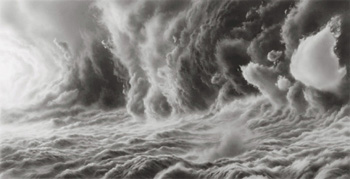Reception: June 5th, 2010 4-6 PM
In reviewing Hilary Brace's drawings, the New York Times said, "once in a while you come across an art of such refined technique that it seems the product of sorcery more than human craft...” Starting with the smooth surface of polyester film darkened with charcoal, Brace works in a reductive manner by removing charcoal with erasers and other hand made tools. Despite the photographic veracity of her technique, Brace composes her images without premeditation, through an explorative process that allows them to unfold in unanticipated directions. Her subjects are based upon clouds, water, mist and mountains, but she takes these forms to sublime and unimaginable new heights. As Christopher Knight remarked in the Los Angeles Times, her work is “like a Vija Celmins drawing made Baroque, [it] conjures ephemeral poetics of light and space.” For all their vastness and grandeur, Brace’s drawings are relatively small and intimate. As Leah Ollman observed in Art in America, these drawings “put those two realms – the private and the cosmic – within reach of each other.”
Concurrently, the gallery will present its first exhibition of the paintings of Marc Bohne. Based in the Pacific Northwest, Bohne visits and then revisits landscapes of particular resonance to him from California to Montana. For this reason, he explains, “I could never be a plein-air painter…it is important for me to process my perceptions, which often need time to form.” Acknowledging “metaphysical threads” to the natural world, Bohne distills these sensations into structured compositions. The objective, he suggests, is to “see deeper into the layers of the landscape, uncovering its harmonies and dissonances, the physical and spiritual tensions.” His oil paintings on panel are not detailed renderings of a place but rather what Emerson called, “a correspondence of the outward world to the inward world of thought and emotions.” For Emerson, “nature is a language and every new fact one learns is a new word.” For Marc Bohne, that language is translated into form, texture and tone.
Concurrently, the gallery will present its first exhibition of the paintings of Marc Bohne. Based in the Pacific Northwest, Bohne visits and then revisits landscapes of particular resonance to him from California to Montana. For this reason, he explains, “I could never be a plein-air painter…it is important for me to process my perceptions, which often need time to form.” Acknowledging “metaphysical threads” to the natural world, Bohne distills these sensations into structured compositions. The objective, he suggests, is to “see deeper into the layers of the landscape, uncovering its harmonies and dissonances, the physical and spiritual tensions.” His oil paintings on panel are not detailed renderings of a place but rather what Emerson called, “a correspondence of the outward world to the inward world of thought and emotions.” For Emerson, “nature is a language and every new fact one learns is a new word.” For Marc Bohne, that language is translated into form, texture and tone.

